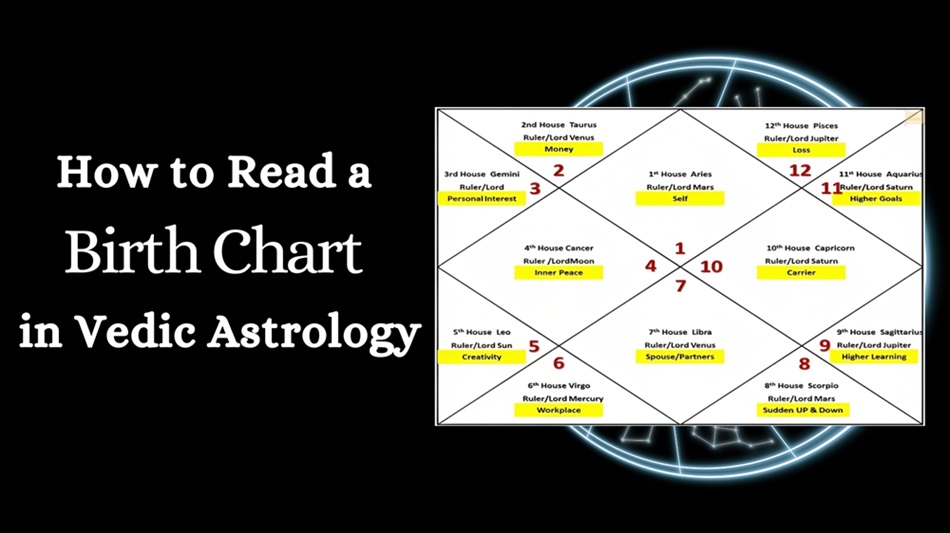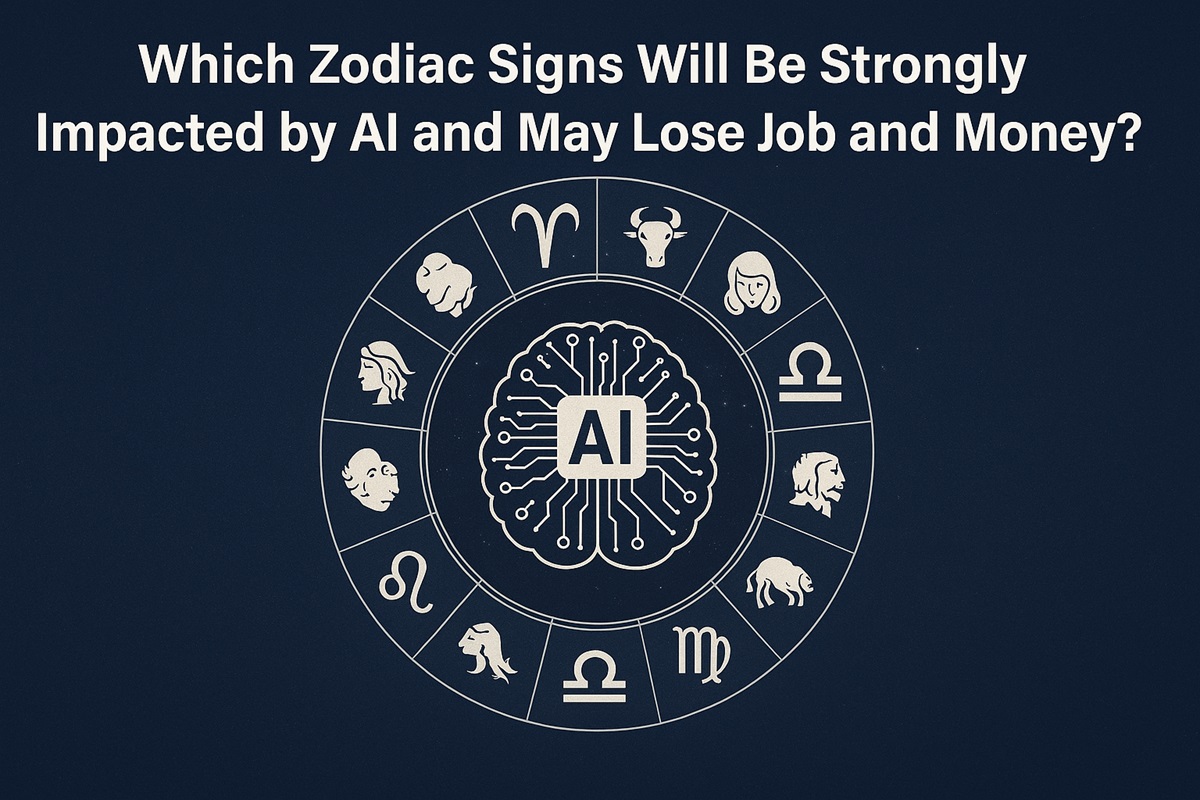Read a Birth Chart: A Step-by-Step Guide for Beginners
Decoding a birth chart can feel like learning a new language. But it’s a fun journey that reveals a lot about you. A birth chart is like a picture of the sky at the exact moment you were born. It maps out the positions of the planets and stars. These celestial clues will help you understand yourself, your emotions, and your life path.
So whether you’re interested in astrology predictions or want to gain more self awareness, this guide will take you through the basics so you can start reading your own birth chart with ease.
What is a Birth Chart?
A birth chart, also known as a natal chart, is a map of the sky at the exact moment and place of your birth. It shows the positions of the planets, the Sun and the Moon within the 12 zodiac signs. In astrology, this is a cosmic blueprint that reveals insights into your personality, strengths, challenges, and life path. Each part of the chart – the zodiac signs, planets, and houses – will give you clues about different areas of your life, including your emotions, relationships, career, and destiny.
The Structure of a Birth Chart
A birth chart is usually a circular diagram of the sky at the time of your birth. This circle is divided into 12 sections called houses, each representing different areas of life, such as relationships, career, and home. Around the outside of the chart, you’ll find the 12 zodiac signs that move through the houses. Inside this circle, the planets are placed according to their position in the sky at the time of your birth, and each planet in a sign and house has its own meaning.
Key Elements of a Birth Chart
The key elements of a birth chart are as follows:
- Zodiac Signs: The 12 zodiac signs, like Aries or Taurus, are the foundational elements of astrology. Each sign has its own set of characteristics and influences the way planets express themselves in your chart. For example, a planet in Leo might express creativity and leadership, while a planet in Virgo might focus on precision and service.
- Planets: The planets represent different parts of your personality and life experience. For instance, the Sun symbolizes your core identity, the Moon relates to your emotions, and Venus governs love and beauty. Each planet’s placement in a sign and house reveals how these aspects of life are expressed in your behavior and experiences.
- Houses: The 12 houses in the chart correspond to different life areas, like personal identity, wealth, communication, and relationships. For example, the 1st house is about self-image, the 7th house deals with partnerships, and the 10th house relates to career and public life.
Lastly, astrology uses a variety of symbols to represent zodiac signs, planets, and aspects (the angles between planets). For example, 
Steps to Read Your Birth Chart
This simple, step-by-step guide is perfect for beginners and will help you decode the key elements of your birth chart, offering insights into your personality, emotions, and life path.
Step 1: Gather Your Birth Details
The first step in reading a birth chart is to gather your birth details, including the exact date, time, and place of your birth. This information is crucial because even a few minutes can change the positions of the planets and the rising sign, leading to different interpretations of your chart. The more precise your birth data, the more accurate and insightful your birth chart will be.
Once you have your birth details, you can easily generate your birth chart online. There are many online astrology websites and free astrology tools available that offer free astrology birth chart calculators. All you need to do is enter your birth information, and the tool will create a chart for you. Additionally, astrology software and apps like Deluxe Astrology provide more advanced features, such as real-time updates, detailed interpretations, and access to various astrological tools.
With accurate birth details, you’re ready to move on to the next steps in reading and interpreting your birth chart.
Step 2: Identify the Rising Sign (Ascendant)
The Rising Sign, also known as the Ascendant, is one of the most important elements in your birth chart. It represents the zodiac sign that was rising on the eastern horizon at the exact moment of your birth.
The Ascendant is crucial because it sets the framework for your entire chart, influencing your outward personality, appearance, and the first impressions you make on others. It acts as the “mask” you wear when interacting with the world, shaping how others perceive you.
To find your Rising Sign, start by looking at your birth chart. The Ascendant is typically marked at the 9 o’clock position on the chart, in the first house. This house represents your self-image and how you present yourself to the world. The sign located at the beginning of this house is your Rising Sign. Once you’ve identified it, you can begin to explore how this sign influences your behavior, style, and interactions with others.
For instance, if your Rising Sign is Aries, you may come across as confident and energetic, while a Cancer Rising might make you appear nurturing and sensitive. The Rising Sign not only colors your outward demeanor but also influences your approach to new situations and challenges.
Step 3: Analyze the Sun Sign
The Sun Sign is often the most well-known aspect of your birth chart and is considered the core of your identity. To locate your Sun Sign in your birth chart, look for the symbol of the Sun (☉) within one of the 12 zodiac signs. The sign where the Sun is positioned on your chart is your Sun Sign.
For example:
- Aries (
): Bold, energetic, and adventurous.
- Taurus (
): Practical, reliable, and grounded.
- Gemini (
): Curious, adaptable, and communicative.
- Cancer (
): Nurturing, intuitive, and sensitive.
- Leo (
): Confident, creative, and passionate.
- Virgo (
): Analytical, detail-oriented, and service-minded.
- Libra (
): Balanced, sociable, and harmony-seeking.
- Scorpio (
): Intense, determined, and transformative.
- Sagittarius (
): Optimistic, adventurous, and philosophical.
- Capricorn (
): Ambitious, disciplined, and responsible.
- Aquarius (
): Innovative, independent, and humanitarian.
- Pisces (
): Compassionate, imaginative, and spiritual.
Step 4: Explore the Moon Sign
The Moon Sign in your birth chart represents your emotional world and subconscious mind. It reflects how you process feelings, your deepest needs, and what brings you comfort. While the Sun Sign shows your outward personality, the Moon Sign reveals your inner self—how you react emotionally, how you nurture yourself and others, and what you need to feel secure.
To locate your Moon Sign in your birth chart, look for the symbol of the Moon (☽). The zodiac sign in which the Moon is placed at the time of your birth is your Moon Sign. This sign will give you insight into your emotional nature and how you relate to others on a deeper, more instinctual level.
For instance, if your Moon is in Taurus, you may seek stability and enjoy sensory pleasures. At the same time, a Moon in Pisces might indicate a strong imagination and a deep connection to the spiritual or artistic realms.
Step 5: Understand the Houses
The planets in your birth chart bring energy to the houses they occupy. When a planet is in a particular house, it influences that area of life with its unique qualities. Some houses hold special significance due to their positioning on the chart’s angles. These are the 1st, 4th, 7th, and 10th houses, often referred to as the angular houses.
- 1st House (Ascendant): This house represents your identity, physical appearance, and how you present yourself to the world. Planets here heavily influence your outward personality.
- 4th House: Known as the house of home and family, it reflects your roots, ancestry, and private life. Planets here impact your emotional foundation and domestic environment.
- 7th House: This house governs relationships and partnerships, including marriage. Planets in the 7th house affect how you relate to others and what you seek in close connections.
- 10th House: The house of career and public life, it shows your ambitions, reputation, and life achievements. Planets in this house influence your professional path and social standing.
Interpreting planets in these key houses involves understanding how their energies interact with the themes of the house they occupy. For example, if Saturn, the planet of discipline, is in your 10th house, it might suggest a strong work ethic and a serious approach to your career. If the Moon is in your 4th house, it could indicate a deep emotional connection to your home and family.
Step 6: Interpreting Planetary Aspects
Aspects are the angles formed between different planets in your birth chart, and they play a crucial role in shaping your personality and life experiences. These angles show how the planets interact with each other, either harmoniously or with tension. The major aspects to know include:
- Conjunction: When two planets are close together, their energies merge and strengthen each other.
- Sextile: A 60-degree angle that indicates opportunities and easy flow between the planets involved.
- Square: A 90-degree angle that creates tension and challenges, pushing you to grow.
- Trine: A 120-degree angle that suggests harmony and natural talent, where planets work together smoothly.
- Opposition: A 180-degree angle that represents a balancing act between opposing forces, often requiring compromise.
To analyze aspects in your birth chart, follow these steps:
- Locate the Planets: Identify the planets you want to examine in your chart.
- Measure the Angles: Determine the angles between these planets using the aspect lines or checking the degrees in your chart.
- Identify the Aspect: Compare the angle to the major aspects (conjunction, sextile, square, trine, opposition) to see which one applies.
- Interpret the Aspect: Consider how the aspect influences the planets involved. For example, a square might indicate tension that needs to be worked through, while a trine suggests easy collaboration.
Step 7: Putting It All Together
Now that you have read the Sun, Moon, Rising Sign, Houses, and Aspects, it’s time to put it all together into one interpretation. To do this, start by looking at how these elements interact and impact each other. For example, your Sun Sign is your core identity, your Moon Sign is your emotional needs, and your Rising Sign is how you show up in the world. By looking at these together, you can get a bigger picture of yourself.
To improve your skills, practice reading charts regularly, starting with your own and others. Journaling, reading, and participating in astrology communities will also help you refine your interpretations over time.
To Sum Up
By following these 7 steps, you’ve taken the first important steps in understanding the rich insights your birth chart can offer. Whether you’re exploring your Sun, Moon, and Rising Signs or delving into the deeper connections between planets and houses, this guide provides a solid foundation for your astrological journey. Here, it is essential to know that reading a birth chart is both an art and a science. So, practice and continuous learning are key to gaining a deeper understanding of yourself and others.
Astrologer Navneet Khanna, is a former World Bank & SIDA consultant, he has held many prestigious projects in India and Africa before settling down in his native place, near Chandigarh and following his passion in Vedic Astrology. Navneet is very scientific and logical in his Predictions. He reasons his predictions because of which he has a worldwide following and people from many countries solve their problems with his help.
He is an expert in Marriage and Love Relationship. In Marriage Matching he does analysis of Guna Milan and also Grah Milan (Matching of the Planets) and will tell you effects and remedies of Nadi Dosha, Bhakoot Dosha & Gana Dosha if present.
He is an Expert Astrologer on Many Indian & Foreign Websites like myastrologysigns.com and a frequent writer for many national and international websites and magazines.
Navneet believes that Vedic Astrology is a vast subject, it is an ocean of knowledge and wisdom. It is simply up to the individual to jump into the ocean and extract the pearls. With his vast experience on occult subjects he has been associated with leading astrologers in India to promote astrology.
Navneet Khanna believes that the energy and inspiration behind him is the Blessings of the Almighty.
You may call / whatsapp him on his number +91-9417884861 .










